
 |

|
|
|
|
Height:
6' (1,83 m) Weight: 167 lbs (75,7 kg) Eyes: blue Hair: auburn Marriage: Mary Elizabeth Patricia Kenny (Jan 19. 1928 - Feb 16. 1979, his death) Children: William Dennis Jr. "Barrie" ( Feb 25. 1929 - Dec 12. 1982) Leslie Howard (Jun 28. 1933 - ) Brother: Edward Francis Gargan (Jul 17. 1902 - Feb 19. 1964), actor |
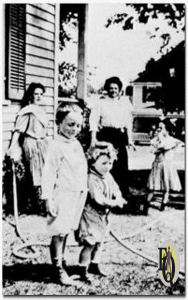 |
|
Above right: William's mother in the background looks at her two
sons, his brother Edward and himself. The two girls are cousins. |
|
|
William Dennis Gargan Jr. was born July 17. 1905 on 427 Henry Street in
Brooklyn, New York, where, it was said, the babies cut their teeth on lampposts.
His parents were William and Irene Gertrude Flynn. His father was a gambler, bill
collector, bookmaker, and saloon owner with connections to the mob. His mother
was a teacher. He was born a twin,
one of seven children, all but he and his older brother Edward died very young.
When Bill was born, an uncle on his father's side gave his brother Ed a small puppy. His brother named the pup Prince and more or less passed the dog over to Bill. They grew up together. Like his uncle, Ed was bigger than Bill, resulting in Bill being called 'Tiny Bill'."
Reportedly Gargan's film debut - albeit uncredited - came at the age of six or seven when he played a young baseball player in a comedy short with John Bunny and Lillian Walker filmed at Brooklyn's Vitagraph Studios.
O
Gargan grew up spending summers in Sea Gate and fighting alongside the Irish kids from Bay Ridge against the Italian kids in empty lots. He played baseball and basketball for St. Francis Xavier grade school and St. James High. In the spring, he shot pool and skipped school to scale the fences of Ebbets Field and watch the Dodgers and their stars of the 1910s — Zack Wheat and Ivan Olson.
By the age of 13 he had worked many adventurous jobs including selling soda at the Ringling Brothers Circus, delivering dry cleaning for a tailor, swept one of his Dad's saloons, worked as a delivery boy for a florist on a bike, wrapping packages at Abraham & Straus Brooklyn department store and other odd jobs like wrapping gifts at a department store.
For ten years, with rare exceptions, from 1911 to 1920, his Dad took them to Saratoga Springs in August for the racing meet. One summer, on August 13. 1919, his father won $57,000 (!). Bill worked at the track that year, as his dad got him a job as a sheet writer on what they called the 'Back Stretch'.
He met Mary Kenny at an ice rink in Prospect Park, Brooklyn. At 14 Bill had wangled a job brushing the ice in exchange for a free ticket to the rink. One afternoon a lithe young thing when flashing by in a seal coat and bright red skirt. He managed to brush her with his broom and knock her flat on purpose. Mary climbed right back up, her eyes spitting fire and her mouth not doing badly either. From that moment Bill knew he was in love. (7) |
|
|
Mary later revealed the true version of their first meeting. This is the way it really happened: I had lived in New York all my life and loved it. One Saturday, when I was about thirteen, my cousin Ellen, who had recently moved to Brooklyn, persuaded me to spend the week-end with her. We both to ice skate, and we decided to try the sating rink near her house. I secured for this occasion a magnificent outfit - at least that was my impression at the time - consisting of a bright red wool skirt and jacket, topped off by a squirrel cap, which I had borrowed from my mother and hastily remodeled. The tail of the cap part stuck out a little in back, giving it a rakish Daniel Boone quality. Feeling distinctly superior to anyone in Brooklyn, I swirled around the rink doing figure eights, and tricky loops, positive that I was cutting a very dashing figure. I was extremely pleased with myself, and completely oblivious to the fascinated stare of a young Brooklynite who was standing by the sidelines, apparently mesmerized by the squirrel tail at the back of my cap. I had just completed a graceful turn when suddenly a blurred figure hurtled toward me. I felt a hand grab for my cap, and the next thing I know I was knocked square on the ice. The figure materialized into a boy with red hair, who was also sprawled on the ice. Apparently there had been a slight miscalculation. But he didn't stay around to explain. He scrambled to his feet and whizzed away into the crowd, before I realized what was happening. Irish temper boiled inside me. My skirt had a rip from stem to stern, and my cap, my beautiful cap, lay mortally wounded on the ice. Ellen came rushing over to me. "Did you see that?". I sputtered furiously. "Did you see what that... that creature did to me?" I was so mad I could hardly talk, which was very unusual for me. "If I just knew who he was." "I know who he is," Ellen said. "Не goes to school with my brother. His name's Bill, but everyone calls him Red. His last name is Deegan or something like that. No, Gargan. That's it, Bill Gargan." "Well," I said, meaningfully "that's very nice to know. Gargan, huh?" The main problem was to figure out next few weeks when I could manage to meet this Gargan fellow again. Ellen told me there was going to be a school dance, where he would probably be, and we decided we should go. Through Ellen's brother I maneuvered an introduction to red-headed Mr. G. Before the evening was over, Bill Gargan, boy steam-roller, was following me around like a dreamy-eyed spaniel. "Gee," he'd say every once in a while. "You sure look familiar." And I would smile innocently up at him. Revenge was sweet. I decided to let Bill take me to the next dance, where I promptly ditched him and gave all my attention to his arch rival, the baseball captain. Then I'd accept dates for the movies, and just not show up. I did all sorts of terrible things to him, and he'd just look more bewildered and crestfallen - and keep calling me up. One day I let him take me for a walk in Central Park. We were just walking along, with me chattering away a mile a minute, when all of a sudden I looked at him, and I felt funny. I don't know what it was-the red hair, the hurt look in the blue eyes that met mine so squarely, or maybe a touch of spring. Whatever it was, that's when I fell in love with Bill because that's when I told him that I was really Squirrel Cap. He just looked in horrified amazement, and we both started to laugh. It was a beautiful moment! From then on there was never anyone else for either of us. We started going together and just never stopped, that's actually talk of marriage until years later. |
|
|
Mary lived in Manhattan but spent weekends in Bay Ridge,
Brooklyn. They hung out in Coney Island at Feltman’s, at Lundy’s in Sheepshead
Bay, or the Loew’s Metropolitan and the Keith’s Prospect. Patricia had really
been christened Mary Elizabeth, so Bill decided to be a little different and
called her Mary. At high school, Bill discovered something else that caught and held his attention. The school put on plays, and it was not long before he was the best actor in school. At least, he was ready to fight anyone who said he wasn't, with few takers. His flair for speechmaking grew so pronounced that he won the gold medal for elocution. He was playing in school productions of Hamlet, Macbeth, and Romeo and Juliet. However, a teacher who’d been out to get Gargan for his comedic behavior made life so miserable during Gargan's senior year that he dropped out. Mary and Bill were together when he got his first job at sixteen years old. He worked one day as a soda jerker, and earned 3 dollars for the day's work. The store was miles from his home and being afraid to be late for work in the morning and late for dinner at home, he took a taxi both ways. At the end of the first day he decided that there was no profit in it. Gargan is know to have had a series of jobs ranging from soda jerking to street car conducting but after leaving high school (1922, St. James School, Brooklyn) he had a number of white collar jobs. At the age of eighteen he decided to become a business man and got a job selling Wesson salad oil to chain stores, in Brooklyn making great commissions. "I've never seen anyone so enthusiastic over a job," Mary Gargan laughed. "Every time he came over to my house for dinner he would bring his salad oil and insisted on mixing salad dressings for us. He made gallons at a time until the house was swimming. It was a lucky thing that the job lasted only two months." He was sneaking away to watch vaudeville shows. One day the lights went up and Gargan noticed his boss was sitting next to him. “Good show,wasn't it” Gargan said, “you’re fired,” answered his boss. Gargan became a message runner for a Broad Street brokerage firm, and credit investigator and investigator for a clothing store. Once Gargan was once shot at when he attempted to get a deadbeat customer to pay his overdue account. Next, at nineteen, he worked for about a year as a private detective with a Wall Street agency for "$10.00 a day and expenses." Gargan did many of the usual detective jobs: guarding payrolls, tailing possible suspects, conducting stakeouts, and protecting clients with valuables. He was fired when he lost track of a diamond salesman he was supposed to be protecting. In 1924 he became bored with the routine of a regular job so he turned to acting. Bill found that on the stage talking is the most fun. Someone took him into the Lambs' Club and it occurred to him that the theatrical business was the best in all the world. To act, and get paid for it, now that was the life! He went to his older brother, who had left the choir in favor of the chorus of Rose Marie (Imperial Theatre, Sep 2. 1924 - Jan 16. 1926) and got himself introduced to sundry gentlemen of the profession. Upon encouragement from playwright Le Roy Clemens Bill auditioned for, and won a part in support of Vivienne Osborne in Aloma of the South Seas (Lyric Theatre, Apr 20. - Jun 1. 1925) on the Broadway stage. They opened in Baltimore in the Old Ford's Theatre in November 1924. Gargan was a quick study, learning everyone’s parts as well as the stage manager’s. Within a year, he was directing the Philadelphia production of the play. Bill first portrayed a gentleman of color. For eight weeks, he would cover himself in a beautiful shade of brown makeup, earning a princely stipend of 30 dollars per week, and perform joyfully as a resident of the enchanted isles. Bill was so exuberant that after two weeks, the management decided to tone him down a bit. Somewhat reluctantly he was reassigned the role of Red Malloy and spent the next 69 weeks portraying a 65-year-old beachcomber. Afterwards, two touring companies were formed one for Philadelphia and one for Chicago. He offered to direct the Philadelphia company and, to his surprise, they agreed. Chicago folded after 3 weeks and it's director took over from Bill in Philadelphia where the play was a success playing forty weeks on the road. It's uncertain if he joined the Broadway cast of Laff That Off (Wallack's Theatre, Nov 2. - Oct 9. 1925) but he did go on tour with Laff That Off to Philadelphia, Baltimore and Boston for one week each, followed by shorter runs of performances throughout the country. Between acting jobs, Gargan got a job selling gin & bootleg whiskey to New York City speakeasies. The rowdy Broadway play Chicago (Music Box Theatre, Dec 30. 1926 - May 28. 1927) was to start a tour. So in the summer of 1927 Bill was contacted by his manager. ** Chicago was a long tour: Chicago, Kansas City, St. Louis, Baltimore, Washington, Boston, and Pittsburg. Bill got bored. When Bill was on the road, Mary got terribly lonesome. One weekend, while he was playing a ten-week run in Baltimore, Mary packed her mother and father and went to visit him. They were very fond of Bill and had no objections to their romance, although they were a bit concerned about him being an actor. When the three appeared, Bill was surprised. "I surrender. Where's the wedding going to be?" he said, laughingly. They started making plans on the spot, and two weeks later they were married. |
|
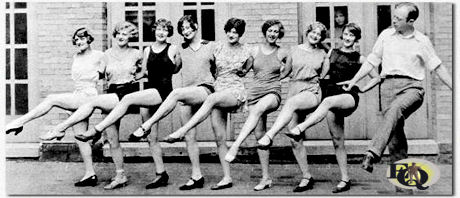 Above: Mary Kenny (third girl from the left in "Russell Markert's Markettes", believed to be one of the predecessors of the famous Rockettes (Missouri Rockets, American Rockets, Rosettes, Roxyettes). Early in their marriage, she became one of the first Rockettes when Radio City Music Hall opened (1932). |
|
|
Bill married Mary Kenny, his childhood sweetheart on January 19. 1928
in Baltimore*. Mary had started out as an actress early in
life. She played child parts for Pathé in New York in the old silent pictures.
Then she graduated to the stage as an acrobatic dancer, working in Ziegfeld,
Earl Carroll and George White productions (Scandals). Patricia had
actually been baptized as Mary Elizabeth, but Bill decided to be original and
named her Mary. They didn't have a honeymoon. Bill had to be at the theater most
of the time. They barely managed to have dinner alone. The play* moved to Atlantic City, Washington's National Theatre, Philadelphia and Boston, where he and Mary stayed in the Arlington Hotel. When the tour ended he had to take his little family to live with his mother-in-law on Garfield Place. |
|
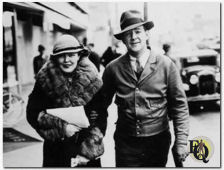 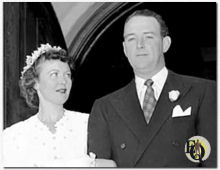 Above left: William and Mary Kenny walking down the street. Above right: Gargan and his wife, Mary, at Palm Springs’ own Our Lady of Solitude Church where they likely have just renewed their vows. The couple was first married in 1928. |
|
|
After the latter Bill was with Richard Bennett in The People, it folded on the road. He then took second lead with a stock company in Cleveland, doing a couple of plays produced by Pat McCoy, a very successful stock producer in the Midwest.In the Playhouse, opposite the old Hollanden Hotel in Cleveland, the first show was a melodrama starring Clark Silvernail, and after a week, they flopped so badly they decided to try a comedy Not Herbert. But Not Herbert (1928) didn't do a bit better.
Later in his career, Bill would claim that he played the role of lieutenant in The War Song (National Theatre, Sep 24. - Dec 1. 1928). However, this only happened during the closing performance in New York. Afterward, he took on that role for the 13-week tour. The Gargans initially both played in the play as Mr. & Mrs James Perkins. On the evening the show closed, Mary Kenny gave birth to their first son, William Dennis Gargan III (Feb 25. 1929) aka "Barrie" after Sir James Matthew Barrie, Mary's favorite playwright.
For the next nine, ten months, Bill couldn't even get a job as a chorus boy. First there was a spell during which Bill eagerly sought and played, mostly uncredited, extra parts in pictures. Such an insignificant part he played in Lucky Boy (Tiffany, Feb 1. 1929) and My Mother's Eyes (1929) both with George Jessel. But these resulted only in a days work. So he didn't have a nickel when one day he encountered Charlie Wilson, the vaudeville man, and, at 75-85$ weekly, got a bit part in show at the Prospect Theatre, Brooklyn only eight blocks away. It was a part in a fifteen-minute sketch called "The Family Upstairs". Just working in this little act made all thoughts of the bad days vanish. He now felt lucky and so he didn't faint when a manager William Farnum called to offer him a real part in a real play Headquarters (Forrest Theatre, Atlantic City, Dec 4. - 31. 1929). He did almost collapse, however, when they told him the salary was around 275 dollars a week. The show ran for 2 weeks.
Other appearance on Broadway followed: City Haul (Hudson Theatre, Dec 30. 1929 - Mar 8. 1930) with Herbert Rawlinson, Out of a Blue Sky (Booth Theatre, Feb 8. - 25. 1930) directed by Leslie Howard, and Roar China (Martin Beck Theatre, Oct 27. - Dec 27. 1930). In the latter a member of the cast tossed him off a ship into thirteen inches of water every night. Outside of a slight limp and a couple of bruises in vital spots, Bill faired well enough in that job.
Meanwhile Mary had found a new apartment, a one bedroom place down from the street level on Union Street, in Brooklyn, close to the Grand Army Plaza (1930).
In total he played in minimum 10 Broadway shows. The last were She Lived Next to the Firehouse (Longacre Theatre, Feb 10. - Mar 1. 1931), and He (Guild Theatre, Sep 21. - Oct 1. 1931).
Now the first of this extra work in movies came along: as a gangster in Follow the Leader (Paramount, Dec 6. 1930), with Ed Wynn and two jobs were in Claudette Colbert pictures: His Woman (Paramount, Nov 21. 1931) and Misleading Lady (Paramount, Apr 15. 1932). Finally in 1932 he won great acclaim ("Drama Critics Award for Outstanding Performance of the Year") for his work in Philip Barry's Broadway play The Animal Kingdom (Broadhurst Theatre, Jan 12. - Jun 1932). Bill wanted the part of "Red Regan" in that show more than anything else. Miller, the producer, and the star, Leslie Howard, both refused him (Fall of 1931). He began trailing the author of the play, and one night he cornered Phil Barry in his hotel and forced him to listen while he read Regan's lines. Barry nodded "All right." Several weeks later, on opening night, the audience acclaimed the new player. In Pittsburgh, during the try-out, Barry wanted to cut the part, but Leslie wouldn't allow it. Then on opening night, Howard, the great star, bowed to thunderous applause, then went over to the wings and pulled out Gargan to share the applause with him, before quietly slipping away to let Gargan take it all alone. He and Leslie Howard developed a lifetime friendship. Gargan even named one of his children after the actor. |
|
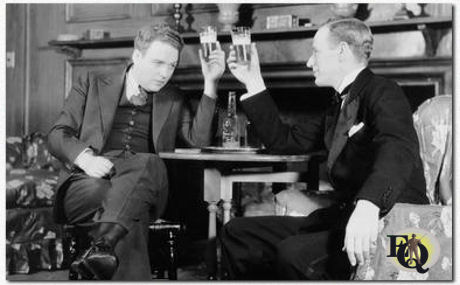 Above: Leslie Howard as Tom Collier and William Gargan as Richard Regan in The Animal Kingdom at the Broadhurst Theatre, New York. January 12, 1932 thru June 1932. |
|
|
RKO Radio Pictures came with an offer and he gave a verbal
promise to sign with them, while contracts were drawn up. Meanwhile MGM came
along with a better offer but he had given his word to the first company. With
them him filmed The Animal Kingdom (RKO Radio Pictures,
Dec 23. 1932). The critical success led to an invitation from Hollywood, lent to United Artists, in a role next to Joan Crawford in Rain (United Artists, Oct 12. 1932). |
|
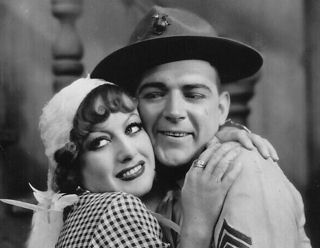
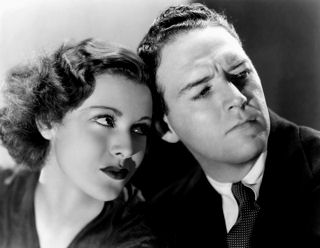 Above left: A W. Somerset Maugham tale provided the story for Rain (United Artists, Oct 12. 1932). Miss Sadie Thompson (Joan Crawford), a prostitute, quickly catches the eye of Sergeant Tim O'Hara (William Gargan) Above right: Headline Shooters (RKO Radio Pictures, Jul 28. 1933) Reporter Bill Allen (William Gargan) gets the story regardless of the consequences but when Allen meets no-nonsense Jane Mallory (Frances Dee) he falls in love. Co-stars included Ralph Bellamy and Jack La Rue. |
|
|
He went to live in Hollywood where he now had a ten-dollar-a-week butler named
Isaac who delighted him half to death. While the sand drove him crazy he did
like having a large house to entertain in. In most of his screen appearances, Gargan basically played himself: a robust, handsome, high-spirited Irishman. Gargan was a member of what is affectionately known in Hollywood as "the Irish Mafia". |
|
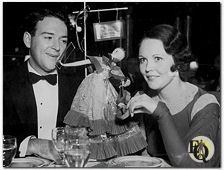  Above left: William Gargan and Mary Kenny at the Hollywood club The Coconut Groove (May 12. 1933) Above right: Mr & Mrs William Gargan with their children, Barrie (the elder) and Leslie Howard Gargan (born Jun 28. 1933). |
|
|
At RKO in 1933, actors were forced to accept a big cut in
salary, because of the depression. Bill was among them. He held a meeting with
fellow actors to determine if they would accept the terms dictated by RKO's
bigwigs - a 50 percent cut in pay. They signed but he refused one clause in the
new contract. It said they relinquish all rights for further compensation in the
event their movies would be sold to television. Everyone else signed. Thinking
television wouldn't happen in their lifetime. It did. Bill didn't have a crystal
ball he just hated giving anything away to the Hollywood moguls.
(7) Bill had moved from his "house of straw" in the Hollywood Hills to an apartment on Cherokee Avenue in Hollywood itself. The first of a series of moves. North Ogden Drive followed where they rented a hillside house, and then found a furnished house at 1515 North Laurel during Christmas of 1933. Much less emphasized are Gargan's appearances on radio shows: Four Frightened People (Jan 21. 1934) and Hollywood On The Air (NBC, Feb 3. 1934). While the former recounted the story of filming the eponymous movie in the jungle, in the latter, Gargan told Jimmy Fidler about his brief career as a private detective and other jobs. |
|
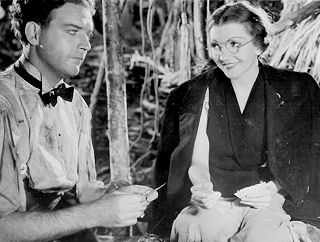
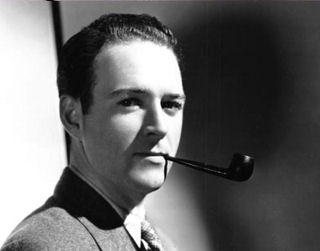 Above left: Stewart Corder (William Gargan) with schoolteacher Judy Jones (Claudette Colbert) in Four Frightened People (Paramount, Jan 26. 1934). Above right: Black Fury (Warner Bros., Apr 10. 1935) brought us William Gargan as Slim Johnson opposite Paul Muni. |
|
|
In 1935, Gargan went to England and made several films.
There he and his wife were the guests of the Leslie Howards in their 400 year
old Tudor house in Surrey, outside of London. The Gargans themselves did not
live in Beverly Hills, where they wanted to be anyway, so upon his return Gargan
rented them the home of Marion Davies' mother at 727 North Bedford Drive, a
Beverly Hills version of an English Tudor and moved in immediately. His other "serious" film work included noteworthy performances in The Story of Temple Drake (Paramount, May 6. 1933), Four Frightened People (Paramount, Jan 26. 1934), and You Only Live Once (United Artists, Jan 23. 1937). |
|
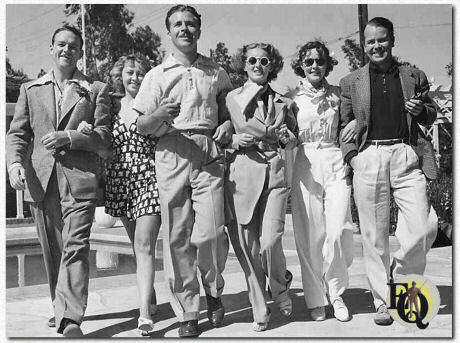 Above: (L-R) Bill Gargan, Joan Blondell, Dick Powell, Betty Davis, Mary Kenny, and Regis Toomey at a pool party thrown by Powell, 1936. |
|
|
Renting houses wasn't really "the Hollywood way". Finally, in June 1937,
Mary discovered that when Jean Harlow died, her house came up for sale.
Seventeen rooms, high vaulted ceilings of natural raw beams, a real Spanish
house.... and so they moved into 512 North Palm Drive. He
had and English bull pup named "Nagrag" (reverse of Gargan). The dog won a prize
at the Palm Springs bench show. (Ending up with two bulldogs Lord and Lady
Nagrag). For his children, he brought from Europe 3 turtles they named
Clayton, Jackson and Durante. |
|
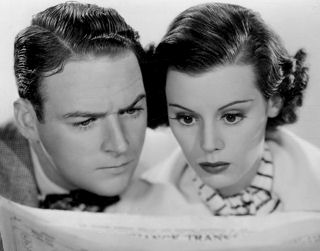
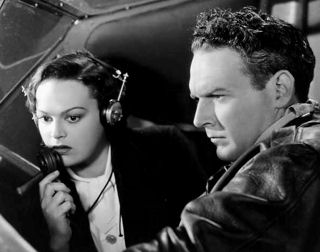 Above left: William Gargan and the wonderful Helen Mack in The Milky Way (Paramount, Jan 31. 1936) a Harold Lloyd talkie. Above right: Sky Parade (Paramount, Apr 19. 1936) In this airborne adventure, three pals from WW I team up to run a commercial airline. Katherine DeMille and William Gargan. |
|
|
From 1939 onwards, there was more regular radio work: The Lux Radio Theatre (CBS, Mar 6. 1939 and Mar 17. 1941, min. 2), Good News of 1940 (NBC, Jan 4. - Feb 22. 1940, min. 7), and guest appearances here and there. |
|

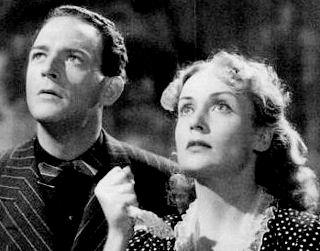 Above left: The House of Fear (Universal, Jun 30. 1939) An actor, John Woodford , dies on stage during a performance of a play. His body is taken to his dressing room, where it disappears. The theatre is closed for over a year, and rumors that Woodford's ghost haunts it spread all over Broadway. A detective (William Gargan), posing as a producer , rents the theatre and attempts to present the same play, but all sorts of "ghostly occurrences" happen to try to thwart his plans. With Irene Hervey, Harvey Stevens. Above right: For his work in They Knew What They Wanted (RKO Radio Pictures, Oct 8.1940), he received a "Best Supporting Actor" Oscar nomination. Here he is pictured with co-star Carole Lombard. |
|
| He played master detective Ellery Queen in three 1942 Columbia programmers opposite Margaret Lindsay's Nikki Porter: A Close Call for Ellery Queen, A Desperate Chance for Ellery Queen en Enemy Agents Meet Ellery Queen. The series could have outlasted the war but the fact that he had no contractual obligation to a studio prevented him to continue the role. "Bellamy's Ellery Queen movies grossed far more than did mine. "He's not Ellery Queen," audiences said of me." The series was so quickly shelved Gargan and Lindsay had to go on in an unrelated movie No Place for a Lady (Columbia, Feb 11. 1943). | |
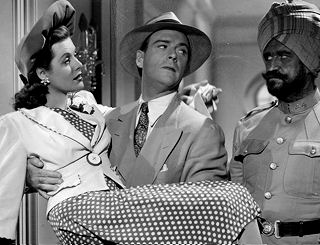
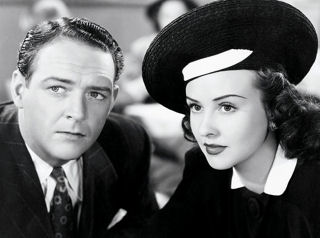 Above left: Irene Hervey with Gargan in the Universal's mystery Bombay Clipper (Universal, Jan 11. 1942) Above right: William Gargan with Margaret Lindsay in A Desperate Chance for Ellery Queen (Columbia, May 7. 1942) |
|
|
In the first week of June of 1943 he made a personal
appearance at the M-G-M owned Capital Theatre on Broadway. The lights were
blacked out and then a white spotlight swooped down on him. When the band played
"Coming in on a Wing and a Prayer" Bill opened by saying, "The
last time I was on Broadway was with Leslie Howard in The Animal Kingdom", just
to remind them he began right there, and was really one of the boys. He went on
but didn't get much response for the first few minutes.
He wondered what was wrong with the opening lines. Then
he stepped outside and there was the headline. "Leslie Howard killed. Plan shot
down over Bay of Biscay." He did the remaining five shows with a stone in his chest. Since 1941, life had stopped being pleasant and predictable for everyone. Bill tried to enlist, but they wouldn't have him. He did, however, join the USO and spent most of the war years overseas. He was the first actor to fly over the Himalayas, and the first to reach the boys in India. At Christmas time 1943, Gargan went on a USO tour together with fellow film performers Claudette Colbert and Keenan Wynn. He spent several months visiting bases in China, Burma and India. Gargan mainly participated in sketches. He was also appreciated for his informal talks with the GI's and Gargan found the experience (which lasted past the first quarter of 1944) to be one of the most rewarding of his entire career. During that time, he wore the uniform of an Army major, because, as he was informed, the enemy never shot majors. |
|
 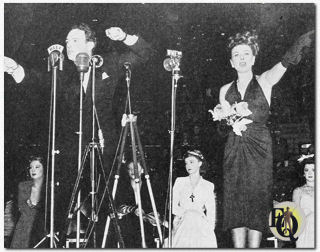 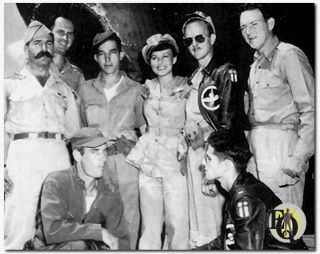 Top left and right: Paulette Goddard auctions off her orchid corsage with William Gargan calling the bids at the War Bond Rally in Madison Square Garden (Sep 30. 1942). Above left: During the war, Bill Gargan led a USO group that included Paulette Goddard, Keenan Wynn, and accordionist Andy Arcari, touring the China-Burma-India theater. For four months, he endured some of the war's harshest conditions, performing shows and traveling in various prop planes despite suffering from an ongoing ear infection. He coped by drinking whatever alcohol was available. Upon returning home, his ear was so swollen that his wife Mary jokingly nicknamed him Dumbo. Above right: After touring China bases, the troup visited bases in India. Here, Paulette Goddard poses with 490th Bomb Squadron personnel at Kurmitola, India. Pilot 1Lt. Angelo J. Brush Mus. William Gargan is on the right. Click on any of the pictures to view a clip of their show (with partial audio loss)! |
|
|
Since Californians felt they had more reason for concern about a Japanese
invasion than other Americans did, many changed their place of residence during
the war years. The Gargans gave up their ranch and rented a house in the San
Fernando Valley. If William Gargan brought an air of authenticity to his roles as a private detective it's because of his youth (father) Gargan learned a lot about the gambling world and met a lot of interesting characters from across the spectrum of society. The main reason why Gargan was so convincing as a detective was that he was probably the only actor of his time who had actually been a private detective. Before heading into TV he had several roles on radio. He took over from Edmond MacDonald as "Inspector Burke" the star of Murder Will Out (ABC, 1945 - 1946). The radio show followed the Ellery Queen formula to a point- each show contained a fully dramatized mystery, followed by guesses from the audience as to the killer's identity. Unlike Queen this contained no trick clues, stories unfolded in chronological order, with the clues considered in the order found. Four contestants (two of each sex) were drawn from the audience. Awards of $5 (in war stamps) were given for each correct answer; winners who guessed the killer and the correct clue won a $50 war bond and a Gold Detective certificate framed for display. |
|
|
He portrayed detective Ross Dolan, a veteran detective who returned to his sleuthing job after being a sailor in WW II. Or as Dolan puts it, "a hitch in Uncle Sugar's Navy" on radio's I Deal in Crime (ABC, 1946 - 1947). As the TV-age became into being it largely took over the existing radio formats of storytelling, quiet an industry at the time. Hence the fact that many stars from radio made the crossover. Indeed he was guest in panels on several radio shows, it wasn't long before he took up the detective parts. |
|
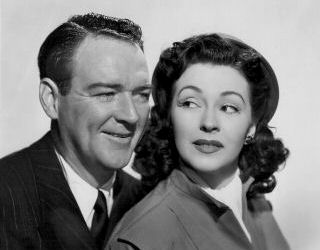
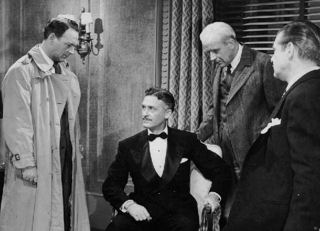 Above left: Follow That Woman (Paramount, Dec 14. 1945) was basically another "Thin Man" derivation, in a wartime setting. The story isn't always up to standard, but William Gargan and Nancy Kelly work quite well together. Above right: "Two women's lives depend on what this man says!" scene from Night Editor (Columbia, Mar 29. 1946) starring William Gargan, Janis Carter, Jeff Donnell. |
|
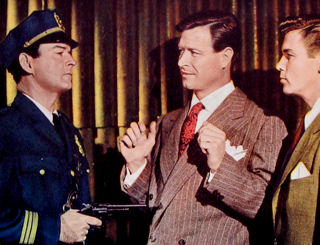
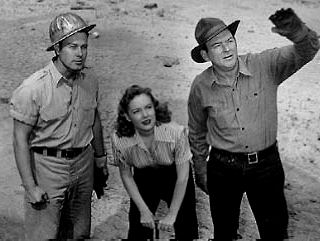 Above left: In Waterfront At Midnight (Paramount, Jun 25. 1949) Gargan (left) portraits a policeman who tries to capture a criminal but ends up charged with murdering his own brother. Above right: Dynamite (Paramount, Jan 18. 1949) contractor William Gargan has his eyes on pretty Virginia Welles, Johnny Brown (Richard Crane) comes along to defy Gargan both at work and in love. In the end disaster comes to the rescue... |
|

|
After the war he found the picture industry changed along with everything else. It was tough to regain his old position and he found the parts he did get were very uninspiring. He didn't just want to be in pictures he wanted to act. It looked as if Hollywood no longer had a real place for him. He decided to rebuild his career. Radio was a possibility, but it was not new to him, but television... that was a challenge! He looked for a niche and went into a huddle with his writer Ted Herdiger. Together they created Martine Kane, Private Eye. He made few films after 1948, but
from 1949 to 1951 he starred in the title role of the TV series Martin Kane,
Private Eye , a series originally conceived for
television but which also had a run over Mutual Radio from 1949-52. On September
1. 1949 it debuted on NBC network and had the 1st Integration of commercials into
shows. Kane enters his favorite tobacco shop & discusses pipe tobaccos and
cigarettes before going to a case, sponsored by United States Tobacco Company. |
|
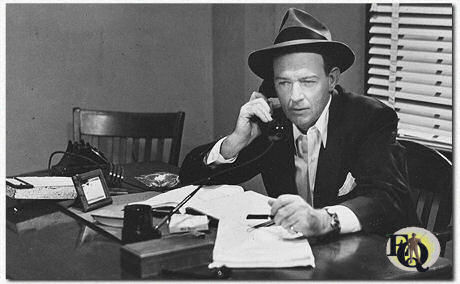 Above: Gargan played Martin Kane in a tongue-in-cheek style, a spoof of the hard boiled private. It became one of the most popular shows on the air. After he left they tried replacing him with several other actors. It didn't work. Gargan was Martine Kane. Nobody else. |
|
|
After Gargan called it quits on the TV series in 1951 he soon found another
role awaiting him on Barry Craig, which debuted over NBC Radio October 3. 1951. "Barry Craig, Confidential Investigator"
(1951 - 1955). The role of Craig may have been just a little too tailor-made for
Gargan. His character's name was spelled originally as "Barry Crane," later
on as "Barrie Craig" and then finally as "Barry Craig." This was due to the protest by the
producers of Martin Kane, charging that “Kane” and “Crane” sounded a little too
similar. So the character’s surname was changed to “Craig.” At the end of the episode "Ghosts Don’t Die in Bed", (Sep 7. 1954) the listener can hear Gargan’s pre-recorded remarks talking about next week’s show ("The Corpse Who Couldn’t Swim"), but he is quickly cut off by announcer John Lang, who reads the program credits and then drops this little bombshell: "We regret that with the program you have just heard, we conclude the present Barry Craig series…we hope you have enjoyed them, and we look forward to bringing them to you again sometime in the not too distant future…" Less than a month later, “the not too distant future” has arrived—the program has been given a reprieve and resumes on October 3. 1954 . It then ran one more season before finally bowing out June 30. 1955. His friend Randy Hale asked him to play with Nancy Coleman & Richard Jaeckel in the stage thriller The Desperate Hours (Aug 1955), opening in The Alcazar in San Francisco, move north to Tacoma, Portland (Oct 1955) and Seattle, and come down to Hollywood, to open there at the Carthay Circle Theatre. The Oakland Tribune wrote , "Not in a couple of blue moons have we seen three performances to equal those of Gargan, Coleman, and Jaeckel. They do terrific jobs." In 1957 Gargan reprised the role of Martin Kane in a syndicated series entitled The New Adventures of Martin Kane. The series was shot on film in Europe in 1956. During his stay in Europe, Gargan (and Mary) had a second audience with the Pope. After the first season Gargan's income took off like a bird. Partly also due to his share in the TV rights for his films. It seemed silly to work much more that year. He and Mary bought a house in Bermuda Dunes, three bedrooms, a swimming pool, Spanish style. |
|
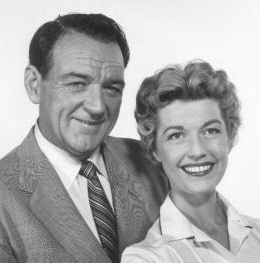 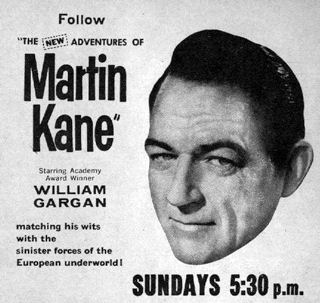 Above left: Gargan playing "Father" in The Ford Television Theatre's "Favorite Son" with Anita Louise (episode # 3.37) 16 June 1955. Above right: Add for The New Adventures of Martin Kane starring Academy Award Winner William Gargan matching his wits with the sinister forces of the European underworld. Sundays 5:30 pm on WNAC-tv 7. |
|
|
For more than 20 years (since 1937) he lived in a seventeen-room house that once was Jean
Harlow's, at 512 North Palm Drive, Beverly Hills, and bought a second house
in Bermuda Dunes, near Palm Springs in 1960. Bill was coaxed out of retirement in 1960 by Randy Hale to play an ex-President who knew he was dying in the play The Best Man. They intended taking it out of town, up and down the Coast and on to Chicago. They began rehearsing the first week of July 1960 in a little theater on La Cienega Boulevard, L.A. After opening in Santa Barbara in early August to great reviews, they moved to the old Alcazar Theatre in San Francisco, where business was so brisk they decided to stay a few weeks before heading to Chicago. The manager was still looking for a new venue in Chicago when he learned he had cancer. He had smoked two and a half packs a day. His business manager was asked to look into his financial matters. With no profession, there was no money coming in. In order to have some money now, he would liquidate whatever assets he had so Mary would have something in case he didn't survive. Stricken by cancer of the larynx, in 1960 his voice box was removed in surgery, ending his career. He learned esophageal speech then taught this method for the American Cancer Society. As Martin Kane Gargan would hang out at Happy McMann's Tobacco shop, touting his sponsor's products now he became an indefatigable campaigner against smoking. He became an active spokesman for the American Cancer Society and formed a production company. While hoping to sell their Beverly Hills house, they put it up for rent, and moved out to Bermuda Dunes. In January 1961, they moved back into 512 North Palm as the rental season was over. The house was still up for sale, but there were no takers. Just then they got and accepted an offer. This was fine, but it left them without a house to live in. Mary and Bill were offered the chance to rent a unit in a duplex on South Elm Drive in Beverly Hills in January 1962. |
|
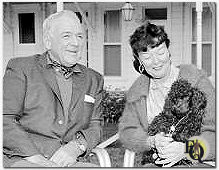 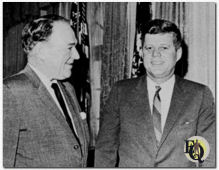 Above left: Picture of Gargan & Mary shot on February 4. 1962. Above right: In 1963 he had the honor of meeting with President John F. Kennedy while in Washington helping to kick off the annual Cancer Crusade. |
|
|
On October 26. 1965, at the Beverly Hills Hotel, he won the Criss Award, Mutual
of Omaha's award for individual contribution to health and safety. He received a
gold medal and a $10,000 tax-free stipend. Tired of the smog Bill and Mary moved in 1966 from Los Angeles. They found a sport at the La Costa Spa and Country Club, ninety miles down the coast and a few miles inland from the ocean at Carlsbad. On November 12. 1967 Gargan received the Screen Actors Guild Lifetime Achievement Award. He described this as "the most thrilling moment of my life". Since he was and always would be an actor at heart. |
|
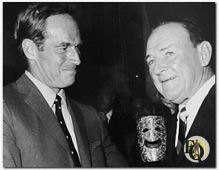 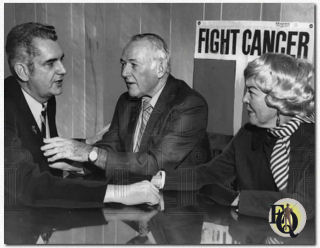 Above left: In 1967, Charlton Heston presented Gargan the Screen Actors Guild Lifetime Achievement Award. Above right: The Gargans with American Cancer Society official in 1970. |
|
 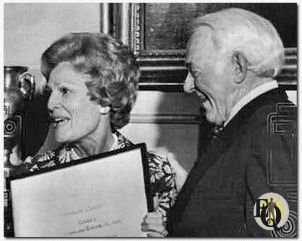 Above left: William Gargan, February 7. 1974 on a meeting of the American Cancer Society volunteers of New Orleans in Baton Rouge. Despite surgery of the larynx Gargan was the featured speaker at the meeting. Above right: Washington, April 18. 1974 - A Kiss and an Award. Veteran actor William Gargan, who lost his larynx to cancer, gets a kiss from First Lady Pat Nixon along with the American Cancer Society's annual "courage award". Thursday at the White House. Gargan said he felt very humble adding "For the first time in my life I can't think of a funny joke." |
|
|
Two years after losing his speech, he gave his final performance, portraying a mute clown on TV in King of Diamonds (ZIV, 1962). He authored an autobiography, Why Me? (1969), recounting his struggle with cancer. William Gargan, 73 years old, died in-flight between NY and San Diego of a heart attack on February 16. 1979. (Not 17!). Mary passed away on January 31. 1983 in San Diego, California at age 76. Gargan had an eventful life, which was to be expected, as Mary once stated, "With Gargan around, anything can happen." - It did. |
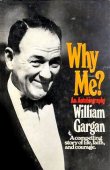 |
|
Above right: He authored an autobiography, Why Me? (1969), recounting his struggle with cancer. |
|
|
Notes: * One source claims (after Aloma of the South Seas) "Then came the forty weeks with Francine Larrimore in Laugh That Off (sic). Bill was on the top of the world and he and Mary got married while the company was playing in Chicago". His biography confirms Baltimore as the place of their marriage. ** Francine Larrimore played with William in Chicago (Music Box Theatre, Dec 30. 1926 - May 28. 1927). Bill as performed this play in Chicago at the Harris Theatre. All dates for movies are for the first US release. All dates for TV programs are original first airdates. All dates for (radio) plays are for the time span the actor was involved. Facts in red still need confirmation. |
|
|
Click on Uncle Sam if you think you can help out...!
|
|
|
Other references
Additional video & audio sources
|
|
|
This actor profile is a part of
Ellery Queen a website on deduction.
The actor above played Ellery Queen in
an Ellery Queen film series.
Click Uncle Sam if you think you can help
out...! Many of the profiles on this site have been compiled after very careful research of various sources. Please quote and cite ethically! |
|
|
Page first published on May 22. 2016 Version x 2.1 - Last updated April 7. 2025 |
|
 b a c k
t o L i s t o f S u s p
e c t s
b a c k
t o L i s t o f S u s p
e c t s
|
|
| Introduction | Floor Plan | Q.B.I. |
List of Suspects | Whodunit? | Q.E.D. | Kill as directed | New | Copyright Copyright © MCMXCIX-MMXXV Ellery Queen, a website on deduction. All rights reserved. |